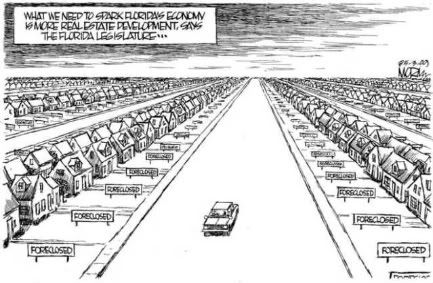








I first posted to this blog in 2007 -- mysteriously, it's now disappeared off St. Augustine Record website.
Residents Draw Line Against Developers
Wednesday, October 06, 2004
RESIDENTS DRAW LINE AGAINST DEVELOPERS
By TIFFANY MERLO
Staff Writer
St. Augustine Record
Diane Mills has spent 35 years living on her Lewis Speedway property, and now spends most of her days looking for ways to protect it from developers.
The latest threat to her land comes from the St. Augustine Planning and Zoning Board’s approval of Tide Water Development’s plan to build 100 homes near Lewis Speedway across the street from Mills.
Known as Old Sebastian Point, the residential single-family development is located on DOT Road on 34 acres. Mills, knowing the sensitivity of the surrounding marshland and fearing flooding problems, questioned how four homes could be allowed on 1 acre of land.
Red House Branch Creek easily overflows during bad storms, and more houses will cause excessive overflow, she said.
But that project is just one of several approved by county and city officials that frighten Mills.
Also nearby, on Woodlawn Road, is the North Florida Commerce Center, another Tide Water Development project. It is a 200,000-square-foot professional office complex.
And then there is the Heritage Planned Unit Development on North Woodlawn Road, which includes 774 homes on 392 acres of land. That will be in Mills’ backyard. Heritage’s western neighbor is expected to be Legends, a proposed sports-themed development.
In addition, there are several smaller subdivisions being built in the area.
What strikes Mills as ominous about all the commercial growth, aside from the disturbance it causes to residential property owners, are the names backing the projects. The same names keep appearing, and in some cases, the names of the corporation and development change and get reworked until finally meeting approval from government officials, she said.
For example, she said Heritage was once known as Plantation Point, owned by Tide Water. Tide Water unsuccessfully tried to annex it into the city in 1997. The name of the corporation changed to Woodlawn Road LLC, and Heritage was named as the development in the county.
Kelly Smith was in on the Plantation Point proposal, the Woodlawn Road development and on Old Sebastian Point.
Mills has also noticed that Robert Graubard, a principal of Woodlawn properties, was also involved with the Heritage development. He and his partner, Robert Laurence, also have ties to Sportstown USA Development Inc. and Lorrington Development Group Inc. — corporations linked to NFL Legends.
Mills most recently spotted a zoning sign at the northwest corner of Woodlawn Road and State Road 16 for the construction of Woodlawn Gas & Go, listing Woodlawn Road LLC as the property owner. Woodlawn Road LLC lists Michael Heffron and Kelly Smith as two of the five partners in the deal.
All of this appears to Mills as a way for developers to get projects approved separately, and avoid a Development of Regional Impact classification and subsequent growth management guidelines.
‘‘I question why we even have zoning at all. It appears the only ones that have to abide by it are the little people,’’ she said.
Heffron and Smith didn’t return phone calls seeking comment. Graubard referred calls to his attorney, Babette Ashley, who was not available for comment.
Mills said she isn’t against development, but wants to level the playing field. She said she will continue to fight what she sees as unfair tactics by developers.
She remembers when Lewis Speedway was completely undeveloped and sparse. Mills said although the area isn’t exclusively residential, it was open rural and most who have chosen to develop built homes.
Mark Cooksey, a Woodlawn Road property owner, has concerns about the damage being done to the land. He thinks many of the projects place too many homes close together on the sensitive areas.
‘‘How can they put a 200,000 square foot building in what in the past has been a residential zone?’’ asked Mills.
Mark Knight, city planning and building director, said in the case of Old Sebastian Point and the North Florida Commerce Center, a development of regional impact isn’t necessary because it is not the same piece of property.
‘‘It is not a common plan of development,’’ he said.
Also, he said, one portion of the North Florida Commerce Center was also approved by the county because of its location.
Sonya Doerr, county principal planner, said the Heritage Planned Unit Development was approved by the county and the appeals period has expired. She said it is not the county’s responsibility to determine if the development is a Development of Regional Impact.
However, Doerr said the county did require that the developers receive a ‘‘binding letter’’ from the Department of Community Affairs prior to beginning development. The letter will state whether or not Heritage is a unified plan of development.
Doerr said it may take months for that to happen, but that the developers agreed to the condition.
Bob Cambric, Department of Community Affairs growth management administrator, said his agency has not received an application for the ‘‘binding letter.’’
Once the application is made, Cambric said his agency has to make sure all the sufficient information is supplied and then will determine if several developments need to be considered as one.
For example, Department of Community Affairs will look to see if the property is owned by the same person, has a common management plan, its physical proximity and shared infrastructure.
Ed Lehman, growth management director with the Northeast Regional Planning Council, said a Development of Regional Impact is based on population figures and the number of units in a plan. For example, a development can have 800 units, which is 80 percent before tripping the 1,000 unit threshold for a Development of Regional Impact.
In the case of the Heritage Planned Unit Development, it has 774 units.
Lehman said if the Department of Community Affairs decides Heritage is a Development of Regional Impact because of neighboring projects, owned by the same developer, then its plans will be reviewed by his agency first and later undergo a regional review.
For now, Mills said she continues to collect documentation that overflows from her office closet. She watches as developers’ ribbons mark surrounding property to ensure they do not encroach on her property, her home.
No comments:
Post a Comment